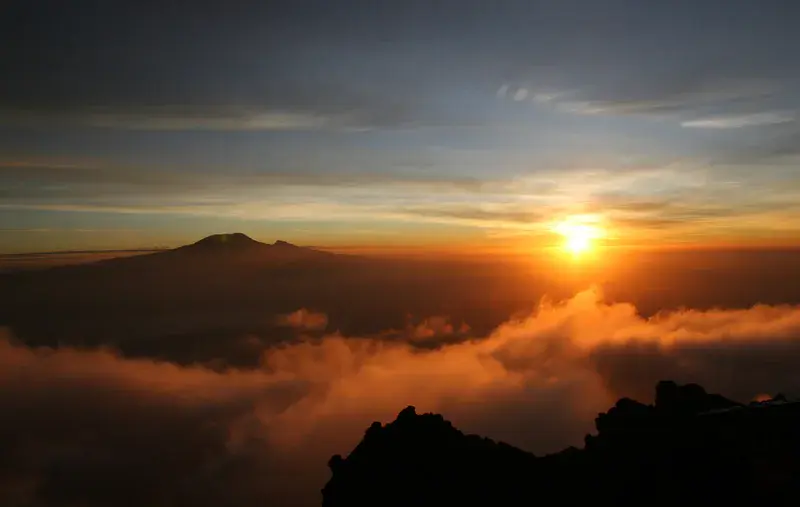
Kilimanjaro from Mount Meru
by Alexis Merlaud, Belgian Institute for Space Aeronomy, Brussels, Belgium
This picture shows Kilimanjaro, Africa’s highest mountain, at sunrise. It was taken from Socialist Peak, which marks the top of Mount Meru, some 70 km to the southwest. Both mountains are located in Tanzania and are among the largest stratovolcanoes of the East African Rift Zone. Unlike Kilimanjaro, Meru is active and its most recent eruption occurred in 1910.
Stratovolcanoes, also called composite cones, are built-up by alternating layers of lava flows, pyroclastic rocks, and volcanic ash. During a large eruption, huge quantities of ash and sulphur dioxide can reach the stratosphere, where they can affect the climate for several years, as did the eruptions of Krakatau in 1883 and Pinatubo in 1991. Sulphur dioxide is converted to sulphuric acid droplets, which spread with the ashes throughout the stratosphere. These aerosols screen some of the sunlight, decreasing the average surface temperature by about one degree. The temperature in the stratosphere simultaneously rises by a few degrees, due to the enhanced absorption of sunlight by aerosols.
There is a difference in the tectonic processes associated with these South East Asian volcanoes and the East African Rift: the former are located above a subduction zone while the rift is a divergent boundary. An example of large volcanic eruption in a divergent zone is the Laki (Iceland) eruption in 1783, which yielded severe meteorological conditions and reduced harvests for several years in Europe. This eruption may have also helped trigger the French Revolution in 1789.
Plate tectonics in East Africa created Kilimajaro and have also played a role in early human evolution, by shaping the local landscape and the long-term climate, thus modifying the environment of our ancestors. East Africa is the area in the world where most of the hominid fossils have been discovered, including Homo sapiens – the oldest fossil record is 200,000 years old and this species started to move out from Africa 100,000 years ago!
Thanks to Cristina Brailescu for help climbing Meru, Emmanuel Dekemper for support on editing the picture, and Fabien Darrouzet for useful discussions. The Laki eruption in 1783 and many other interesting things are mentioned in the scientific novel (in French) 'Brume', by François Brouyaux, who is also thanked for useful discussions.
Featured on GeoLog, the official blog of the European Geosciences Union
Category
Location
- Africa (374)
- Eastern Africa (105)
- United Republic of Tanzania (19)
- Exact location (36.7500 E, -3.2400 S)
Colours
Image properties
3383 × 2142 px;
image/jpeg; 3.4 MB
Camera:
Canon EOS 20D
Taken on 15
February
2012
Submitted on 17 December 2013
Licence
Creative Commons Attribution 3.0 Unported (CC BY 3.0)
Credit
Alexis Merlaud (distributed via imaggeo.egu.eu)
Share
Appreciate
Report